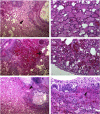Use of the Aerosol Rabbitpox Virus Model for Evaluation of Anti-Poxvirus Agents
- PMID: 20953322
- PMCID: PMC2954426
- DOI: 10.3390/v2092096
Use of the Aerosol Rabbitpox Virus Model for Evaluation of Anti-Poxvirus Agents
Abstract
Smallpox is an acute disease caused by infection with variola virus that has had historic effects on the human population due to its virulence and infectivity. Because variola remains a threat to humans, the discovery and development of novel pox therapeutics and vaccines has been an area of intense focus. As variola is a uniquely human virus lacking a robust animal model, the development of rational therapeutic or vaccine approaches for variola requires the use of model systems that reflect the clinical aspects of human infection. Many laboratory animal models of poxviral disease have been developed over the years to study host response and to evaluate new therapeutics and vaccines for the treatment or prevention of human smallpox. Rabbitpox (rabbitpox virus infection in rabbits) is a severe and often lethal infection that has been identified as an ideal disease model for the study of poxviruses in a non-rodent species. The aerosol infection model (aerosolized rabbitpox infection) embodies many of the desired aspects of the disease syndrome that involves the respiratory system and thus may serve as an appropriate model for evaluation of antivirals under development for the therapeutic treatment of human smallpox. In this review we summarize the aerosol model of rabbitpox, discuss the development efforts that have thus far used this model for antiviral testing, and comment on the prospects for its use in future evaluations requiring a poxviral model with a focus on respiratory infection.
Figures



Similar articles
-
Rabbitpox: a model of airborne transmission of smallpox.J Gen Virol. 2011 Jan;92(Pt 1):31-5. doi: 10.1099/vir.0.026237-0. Epub 2010 Oct 21. J Gen Virol. 2011. PMID: 20965981 Review.
-
Rabbitpox in New Zealand White Rabbits: A Therapeutic Model for Evaluation of Poxvirus Medical Countermeasures Under the FDA Animal Rule.Front Cell Infect Microbiol. 2018 Oct 5;8:356. doi: 10.3389/fcimb.2018.00356. eCollection 2018. Front Cell Infect Microbiol. 2018. PMID: 30345258 Free PMC article.
-
Efficacy of CMX001 as a post exposure antiviral in New Zealand White rabbits infected with rabbitpox virus, a model for orthopoxvirus infections of humans.Viruses. 2011 Jan;3(1):47-62. doi: 10.3390/v3010047. Viruses. 2011. PMID: 21373379 Free PMC article. Review.
-
The efficacy and pharmacokinetics of brincidofovir for the treatment of lethal rabbitpox virus infection: a model of smallpox disease.Antiviral Res. 2015 May;117:115-21. doi: 10.1016/j.antiviral.2015.02.007. Epub 2015 Mar 4. Antiviral Res. 2015. PMID: 25746331
-
Protection of rabbits and immunodeficient mice against lethal poxvirus infections by human monoclonal antibodies.PLoS One. 2012;7(11):e48706. doi: 10.1371/journal.pone.0048706. Epub 2012 Nov 2. PLoS One. 2012. PMID: 23133652 Free PMC article.
Cited by
-
Drug Development against Smallpox: Present and Future.Antimicrob Agents Chemother. 2020 Mar 24;64(4):e01683-19. doi: 10.1128/AAC.01683-19. Print 2020 Mar 24. Antimicrob Agents Chemother. 2020. PMID: 31932370 Free PMC article. Review.
-
Orthopoxvirus inhibitors that are active in animal models: an update from 2008 to 2012.Future Virol. 2013 Sep;8(9):891-901. doi: 10.2217/fvl.13.76. Future Virol. 2013. PMID: 24563659 Free PMC article.
-
ABSL-4 aerobiology biosafety and technology at the NIH/NIAID integrated research facility at Fort Detrick.Viruses. 2014 Jan 7;6(1):137-50. doi: 10.3390/v6010137. Viruses. 2014. PMID: 24402304 Free PMC article.
-
Evaluation of disease and viral biomarkers as triggers for therapeutic intervention in respiratory mousepox - an animal model of smallpox.Antiviral Res. 2012 Apr;94(1):44-53. doi: 10.1016/j.antiviral.2012.02.005. Epub 2012 Feb 18. Antiviral Res. 2012. PMID: 22381921 Free PMC article.
-
Viral infections of rabbits.Vet Clin North Am Exot Anim Pract. 2013 May;16(2):437-68. doi: 10.1016/j.cvex.2013.02.002. Epub 2013 Mar 17. Vet Clin North Am Exot Anim Pract. 2013. PMID: 23642871 Free PMC article. Review.
References
-
- Wallin A, Luksiene Z, Zagminas K, Surkiene G. Public health and bioterrorism: Renewed threat of anthrax and smallpox. Medicina (Kaunas) 2007;43:278–284. - PubMed
-
- Jansen J. Experimenteel onderzoek van Kon-ijnensterfte door een filteebaar virus. Tijdschr Diergeneesk. 1942;69:505–514.
-
- Greene HSN. A pandemic of rabbit-pox. Proc Soc Exp Biol Med. 1933;30:892–894.
-
- Li G, Chen N, Roper RL, Feng Z, Hunter A, Danila M, Lefkowitz EJ, Buller RM, Upton C. Complete coding sequences of the rabbitpox virus genome. J Gen Virol. 2005;86:2969–2977. - PubMed
Grants and funding
LinkOut - more resources
Full Text Sources
Other Literature Sources
Research Materials
